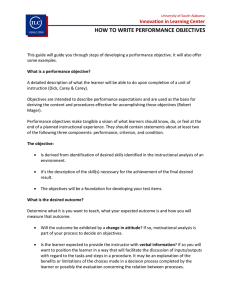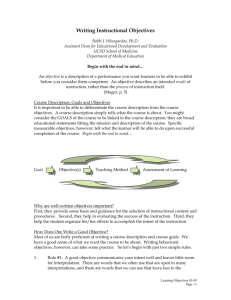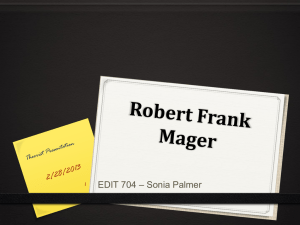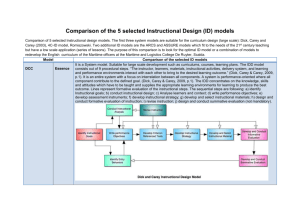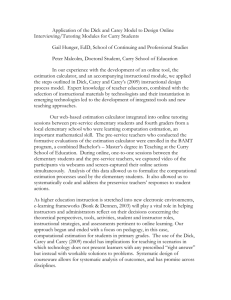Instructional Design Principles
advertisement
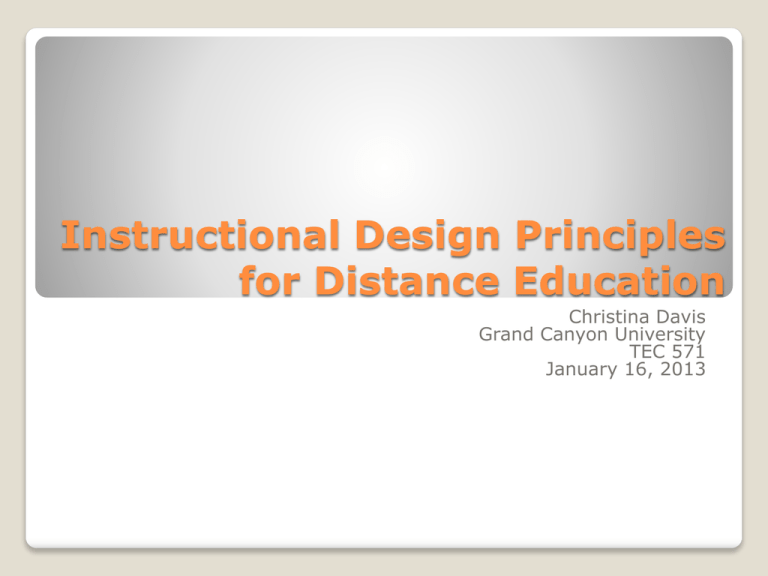
Instructional Design Principles for Distance Education Christina Davis Grand Canyon University TEC 571 January 16, 2013 from svdef.wordpress.com Organization and Planning Careful planning, balancing activities, and organizing learning must take place well in advance of scheduled instruction. from Teaching and Learning at a Distance from instructionaldesign.org Dick and Carey model Brainstorm Visual plan of action Find and create content Create modules Guiding students to learning Unit-major division of a course Module-basis for class discussion and instruction, usually one week Topic-lesson or presentation lasting one class session or discussion thread Organization Unit Module Topic Organization The topic is part of a larger module which is part of a larger unit. Communication Initial and continuous communication as consistent meaningful dialogue between instructor and student serves as a basic principle of online teaching. From Best Practices for Online Instructors Inclusive dates Topics Learning outcomes Required readings Questions for forum discussion Due dates Any other relative information Weekly Schedules Instructor learner Instructor learner Learner learner Maintain 2-way communication Email ◦ ◦ ◦ ◦ 1 to 1 1 to several 1 to all Within groups Announcements Blogs Phone Communication Interaction Presentation of information to students as well as the students’ responses Method Lectures Question and answer, Brainstorming activities Case studies Interviews Learner-instructor Interaction Instructor provides opportunities for group work Method Learner-learner Cooperative learning projects Debates Role-playing Forum discussions Interaction Students reflect on and interact with ideas and concepts Method Learner-content Individual projects Homework assignments Interviews Surveys from dpageek.wordpress.com Graphic design principles Because a large part of elearning involves the learner viewing the screen, it’s critical that the visual elements you choose enhance the learning experience. from 3 Graphic Design Principles for Instructional Design Success Use layouts to convey meaning and create relationships to guide learning Layout What is the relationship between these characters? Is there one? Does proximity and spacing effect the interpretation? Use patterns and repetition to organize content to give learners visual cues about how the content fits together Organize content Web-users are used to quickly scanning for information This information is difficult to process because it all runs together What does this information mean to you? Repetitive elements such as the bold headline and underlined section headers help the learner know how information is related This is easier to process Chunking the information helps learners sort the information and understand how it fits together Limit information to necessary images Bells and whistles may actually impede the learning process Course development best practices. (2004). Roadmap to Effective Distance Education Instructional Design. Retrieved from http://www.google.com/url?sa=t&rct=j&q=&esrc=s&source=web&cd=3&ved=0CEUQFjAC&url=http%3A%2 F%2Fwww.umsl.edu%2Fservices%2Fctl%2FDEID%2Fdestination11firsttime%2Fbmps.pdf&ei=rXj3UKa6OZ DdqwGtyYCgCg&usg=AFQjCNF4uwbQQXY5sDGMs7apAL6N_salsw&sig2=5t5Fh7H4t2dSQNTGQJXgZw&bvm= bv.41018144,d.aWM Dick and carey model. (2013). Instructional Design.org. Retrieved from http://www.instructionaldesign.org/models/dick_carey_model.html Fish, W. W., & Wickersham, L. E. (2009). BEST PRACTICES FOR ONLINE INSTRUCTORS: Reminders. Quarterly Review Of Distance Education, 10(3), 279-284. Retrieved from http://ehis.ebscohost.com.library.gcu.edu:2048/ehost/detail?sid=9f91d46f-4627-4059-bf33e619969d49b4%40sessionmgr115&vid=3&hid=101&bdata=JnNpdGU9ZWhvc3QtbGl2ZSZzY29wZT1zaXRl# db=a9h&AN=48074516 Kuhlmann, T. (2008). 3 graphic design principles for instructional design success. Retrieved from http://www.articulate.com/rapid-elearning/3-graphic-design-principles-for-instructional-design-success/ Principles of online design. (2006). Florida Gulf Coast University Faculty Development and Support. Retrieved from http://www.fgcu.edu/onlinedesign/mediadev.html Simonson, M., Smaldino, S., Albright, M, & Zvack, S. (2009). Teaching and learning at a distance: Foundations of distance education. Boston: Allyn & Bacon. References

